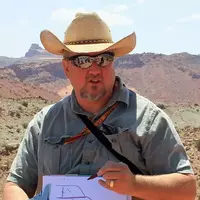Mixed-methods research on student geoscience learning at Grand Canyon by complementary in-situ and virtual modalities
Poster Session Part of
Wednesday Session
Authors
 Steven Semken, Arizona State University at the Tempe Campus
Steven Semken, Arizona State University at the Tempe Campus
 Thomas Ruberto, Arizona State University at the Tempe Campus
Thomas Ruberto, Arizona State University at the Tempe Campus
 Chris Mead, Arizona State University at the Tempe Campus
Chris Mead, Arizona State University at the Tempe Campus
 Geoffrey Bruce, Arizona State University at the Tempe Campus
Geoffrey Bruce, Arizona State University at the Tempe Campus
 Sanlyn Buxner, The University of Arizona
Sanlyn Buxner, The University of Arizona
 Ariel Anbar, Arizona State University at the Tempe Campus
Ariel Anbar, Arizona State University at the Tempe Campus
Not all students enjoy equal access to field-based geoscience learning, even as ever more immersive, rich, and student-centered virtual field experiences become more widely available. No virtual modalities yet conceived can supplant field-based learning, but logistical and financial contraints can render them the only practical option for enabling most students to explore exemplary but inaccessible places located across—and even beyond—Earth. Our team is a leading producer of immersive virtual field trips (iVFTs) and we are engaged in concurrent research on the effectiveness of iVFTs. Given that virtual and in-situ modalities have distinct advantages and disadvantages, our research methods are more complementary than comparative.
We conducted mixed-methods studies in an intro historical-geology class (n = 120) populated mostly by non-majors and an advanced regional geology class (n = 48) that serves mostly majors. Both represent the diversity of our large urban Southwestern research university. For the same credit, students chose either an in-person field trip (ipFT) to Grand Canyon National Park (control group) or an online Grand Canyon iVFT (experimental group) to be done in the same time interval. We collected quantitative and qualitative data from both groups before, during, and after both interventions. Learning outcomes based on elements of the Trail of Time at Grand Canyon were assessed using pre/post concept sketching and inquiry exercises. Student attitudes and novelty-space factors were assessed pre- and post-intervention using the PANAS instrument of Watson and Clark and with questionnaires for each modality. Analysis of pre/post concept sketches indicated improved visualization and conceptual knowledge in both groups, but more so in the iVFT group. Emergent themes from the pre/post questionnaires and PANAS yielded testable ideas to enhance iVFT usability and ipFT accessibility and support the value of iVFTs as pedagogically sound tailored geoscience learning experiences.
We conducted mixed-methods studies in an intro historical-geology class (n = 120) populated mostly by non-majors and an advanced regional geology class (n = 48) that serves mostly majors. Both represent the diversity of our large urban Southwestern research university. For the same credit, students chose either an in-person field trip (ipFT) to Grand Canyon National Park (control group) or an online Grand Canyon iVFT (experimental group) to be done in the same time interval. We collected quantitative and qualitative data from both groups before, during, and after both interventions. Learning outcomes based on elements of the Trail of Time at Grand Canyon were assessed using pre/post concept sketching and inquiry exercises. Student attitudes and novelty-space factors were assessed pre- and post-intervention using the PANAS instrument of Watson and Clark and with questionnaires for each modality. Analysis of pre/post concept sketches indicated improved visualization and conceptual knowledge in both groups, but more so in the iVFT group. Emergent themes from the pre/post questionnaires and PANAS yielded testable ideas to enhance iVFT usability and ipFT accessibility and support the value of iVFTs as pedagogically sound tailored geoscience learning experiences.
Mixed-methods research on student geoscience learning at Grand Canyon by complementary in-situ and virtual modalities (Poster) ( 1.4MB Jul17 17)
